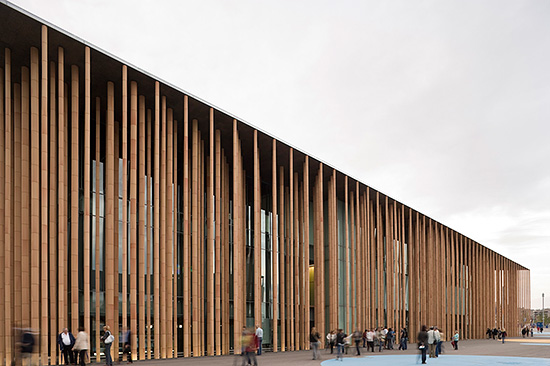Ceramic Tile: Solutions for Holistic Sustainability
Pathways to Green—and Blue
By choosing ceramic tile, project teams can be certain that they are using a material that fits in with their sustainable design and construction goals, without having to worry about qualities that might invalidate its qualification. This dovetails with a number of pathways to achieving sustainability—including the blue components that benefit people, according to Fenwick Iribarren Architects. Among the multiple approaches to sustainability for specifiers to use are:
• Passive House, or PHIUS+ 2015, a new standard launched by the Passive House Institute US this year—under a U.S. Department of Energy Building America Grant—centers on “aggressive energy and carbon reduction” as well as cost effectiveness by considering climate zone, source energy, and operating variables. The standards were developed over three years by the PHIUS Technical Committee and Building Science Corporation.
• LEED v4 will become the required standard by the end of October 2016. The developers at the U.S. Green Building Council call it “bolder, more specialized, and designed for a better user experience.” It includes new market sector adaptations for such building types as data centers and warehouses, as well as a reorganized credit structure.
• ASHRAE 189.1-2011, Design of High-Performance Green Buildings, provides a mandatory-language standard intended for adoption by codemaking bodies. Similar to LEED, it addresses building sites, water use, energy efficiency, general environmental impact, and IEQ.
• IgCC 2015, the International Green Construction Code, is similar: It serves as an “overlay code” that works in combination with the 2015 International Energy Conservation Code (IECC) and others by the International Code Council.
These and other green standards (and codes) provide for review of the sustainability inherent in building materials and finishes selected for occupied zones. The criteria are similar in many respects—material toxicity and safety, embodied energy, manufacturer and supply chain transparency, constituent renewability, and perpetual resources, among others. Yet they also diverge in some valuable respects.
For example, consider the application of ceramic tile in terms of its potential contribution toward certification for the new Passive House standard PHIUS+ 2015. Two of the standards three main “pillars”—space conditioning and air-tightness—are enhanced by the use of finish systems such as ceramic tile. The air-tightness requirement in PHIUS+ provides for a limit of 0.05 cubic feet per minute (cfm) when 50 Pascals of air pressure are applied, for example by using as blower door test. If designed with proper grouts and mortars, joinery, flashing, and vapor barriers, finishes such as ceramic tile provide an airtight vertical or horizontal enclosure assembly that easily exceeds the minimum PHIUS+ levels.
“For space conditioning,” according to Passive House Institute U.S., “the designer focuses first on reducing heating and cooling energy use by passive means.” These include envelope improvement that must be done “cost-competitively” with respect to energy metrics and climate. “This is a good match for a finish system like ceramic tile,” says Fasan, who frequently speaks on sustainable design. “Ceramic tile has a high thermal mass and low conductivity, and it can promote or mitigate as required, passive solar gain. It also offers qualities of slow radiation or dissipation of heat, which can help keep a building warm at night, if desired.”
With these qualities, ceramic tile can be built into passive systems with benefits both for the occupant experience as well as for energy use reductions.
EPDs and Environmental Product Certifications
Such approaches to passive design benefit the end-users and project owners during the lifetime of their building—50 or 100 years or more. This is the ultimate issue facing architects who plan to build as green as possible: operations.
Operating costs should be a major driver for material selection. Life-cycle cost assessments (LCA) include upfront costs, maintenance, and replacement costs. They also include the time expended and financial outlays for upkeep, renovations, and the like. Lowest-cost options on an LCA basis, such as ceramic tile, help reduce material costs, labor, and maintenance needs over any property lifespan. This is a benefit to building owners and occupants.
Yet a key question about the manufacturing phase remains: What are the environmental impacts of the resource extraction, industrial processes, and product distribution? A valuable tool now commonly used to compare these LCA data is the environmental product declaration, or EPD, which lists environmental and manufacturing inputs for a given product or assembly. Based on a cradle-to-grave LCA, an EPD certified by UL uses an ISO-compliant method to calculate the environmental footprint of the products at each stage of the supply chain, during product use, and at end of use. “Product category rules, or PCRs, set consistent and comparable metrics for each product category or industrial sector,” says Fasan. “For example, they give useful estimates of product service life based on durability criteria from ISO as well as ANSI and ASTM.”
The multi-attribute LCA standards are useful for architects hoping to validate manufacturer claims. The Green Squared or G2 Standard ANSI A138.1 launched recently by TCNA employs well-regarded multi-attribute standards from other industries to provide rigorous LCA data for ceramic, porcelain, pressed floor, mosaic, quarry, and glazed wall tiles—as well as related materials including mortar, grout, membranes, and backerboards. “This made Green Squared the first sustainable building material standard to encompass all installation materials for a major product category in building materials,” according to Tile of Spain’s Fasan.
This kind of generic, industry-wide LCA used for EPD creation is known as a Type III product declaration—an international, multi-attribute standard overseen by an independent agency called a Program Operator. The European Union’s standard called Ecolabel is an example: Any company whose products bear the EU Ecolabel have been certified against the EPD criteria, including:
• Applicable life-cycle and supply-chain phases
• Social and environmental attributes
The EU standard also provides for a kind of reciprocity and mutual recognition with other ISO-based EPDs around the world. It offers some valuable material for architects and their clients, too, such as details on the standard details and how often it is reviewed and updated.
Similar to the holistic approach to product selection now driving today’s sustainable design standards, product labeling has become a rigorous, multi-attribute overview. Products meeting a slew of requirements offer greater appeal to building owners and occupants than those that merely pass a VOC off-gassing test.
Multi-attribute selections will increase the use of some longstanding material choices, such as ceramic tile in nontraditional applications, such as very large-format installations and as rainscreens for facades. Unlike many newer categories that may have lower first costs, tile shows how to achieve durability, resilience, and return-on-investment by using recycled content and perpetual resources with increasingly efficient production methods. In the current green design framework, architects are gravitating toward products like ceramic and porcelain tile which are built for a very long life-cycle and have potential for reuse.
Recent buildings and interior projects also highlight the ways in which ceramic tile can affect occupant welfare and cultural needs, which are becoming essential features of holistic comparative material analysis. Pleasure and wellbeing —ideas from classic utilitarianism—may not yet have a place on the eco-labels and certifications for green building materials. But these outcomes are essential to sustainability standards and to quantifying the effects of our product selections on society.
Endnotes
- https://bloomington.in.gov/green-building-benefits
- http://bta.seattleschools.org/assets/Uploads/documents/Building_Green_Enhances.pdf
- http://www.researchgate.net/publication/260016614_Energy_saving_in_ceramic_tile_kilns_
Cooling_gas_heat_recovery - http://www.madehow.com/Volume-1/Ceramic-Tile.html
- http://www.exponent.com/construction_materials/
- https://www.cornellengineers.com.au/a-holistic-approach-to-building-sustainability/
- http://www.designsforcreation.com.au/the-25-principles-of-baubiologie.html
- http://www.usgbc.org/articles/classic-timeless-and-sustainable-cities-jiaming-investment-looks-towards-future
Chris Sullivan is an author and principal of C.C. Sullivan (www.ccsullivan.com), a marketing agency focused on architecture, construction, and building products.
 |
Tile of Spain is the international brand representing 125 ceramic tile manufacturers belonging to the Spanish Ceramic Tile Manufacturers’ Association (ASCER). Its objective is to support and promote Spain’s tile manufacturers and industry worldwide. www.tileofspainusa.com |









